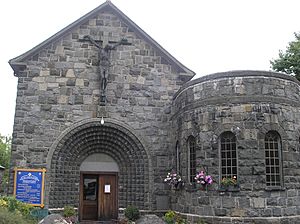Our Lady of Seven Sorrows Church, Dolgellau facts for kids
Quick facts for kids Our Lady of Sorrows Church |
|
|---|---|
| Our Lady of Seven Sorrows, Dolgellau | |

Exterior
|
|
| 52°44′30″N 3°53′05″W / 52.7416°N 3.8846°W | |
| OS grid reference | SH7285417665 |
| Location | Dolgellau, Gwynedd |
| Country | United Kingdom |
| Denomination | Roman Catholic |
| Website | Parish site |
| History | |
| Status | Active |
| Founder(s) | Fr Francis Scalpell |
| Dedication | Our Lady of Sorrows |
| Consecrated | 15 May 1967 |
| Architecture | |
| Functional status | Parish church |
| Heritage designation | Grade II listed |
| Designated | 9 August 2007 |
| Architect(s) | Maurice Pritchard |
| Style | Romanesque Revival |
| Groundbreaking | 1963 |
| Completed | September 1966 |
| Construction cost | £68,000 |
| Specifications | |
| Capacity | 200 |
| Length | 88 ft (27 m) |
| Width | 33 ft (10 m) |
| Height | 28 ft (8.5 m) |
| Administration | |
| Deanery | Dolgellau |
| Diocese | Wrexham |
| Province | Cardiff |
Our Lady of Sorrows Church, also known as Our Lady of Seven Sorrows Church, is a Roman Catholic parish church located in Dolgellau, Gwynedd. It was built in 1966 and is considered a special historical building, listed as Grade II. You can find it on Meyrick Street, very close to the town centre. This church is part of the Diocese of Wrexham.
Contents
The Church's Story
How It All Began
The idea for this church came from a priest named Fr. Francis Scalpell. He was from Malta and became a priest in Rome in 1921. Later, he moved to Liverpool in 1926. There, he helped start a church called St Anthony of Padua. In 1938, he moved to Haverfordwest, and then to Dolgellau in 1939.
When Fr. Scalpell first arrived in Dolgellau, there was no proper place for Catholics to worship. So, church services were held in an old stable. This stable had holes in its walls and roof! Fr. Scalpell himself lived in the attic of a nearby barn, which also had holes in its roof. Later, the old stable was fixed up and made bigger. It was joined to a building that used to be a Fish and chip shop. During the Second World War, Italian prisoners of war even helped to put in the wooden floor and wall panels.
Building a New Church
By the 1950s, more and more Catholic people were living in the area. Fr. Scalpell realized they needed a new, larger church. He worked very hard, writing over 25,000 letters to people all over the world to ask for donations.
A special story is told about how the church got its funding. In the early 1960s, after a Sunday service, a person who was unknown to Fr. Scalpell and the church members stayed behind. This person asked Fr. Scalpell how much more money was needed for the new church. Fr. Scalpell told them the amount. The person then said the money would be given, but they wanted to remain a secret. They also said the church "must be a fine building, harmonising with its austere, mountainous surroundings." Two days later, Fr. Scalpell received a letter from a lawyer confirming the donation.
Construction and Opening
Building work for the new church started in 1963 and took four years to complete. The total cost was £68,000. The architect, Maurice Pritchard, and the builders, John Evans and Sons, were all from the local area.
The church was built in a Norman style, which is a type of old European building design. Above the main entrance, there is a beautiful crucifix. This crucifix was designed by Benigno Mörlin Visconti Castiglione, a sculptor from Milan, Italy. His artwork can also be seen in famous places like Milan Cathedral and St. Peter's Basilica in Rome.
The church officially opened in September 1966. It was formally blessed and dedicated on May 15, 1967, by the Bishop of Menevia, John Edward Petit.
Church Services
Inside the parish, there is also a convent run by the Carmelites, who are a group of religious sisters. The local priest holds a church service there every Sunday at 5:00 PM. In the main church building, Sunday services are held in the morning at 9:00 AM.
Gallery
See also
- Dolgellau
- Diocese of Wrexham





